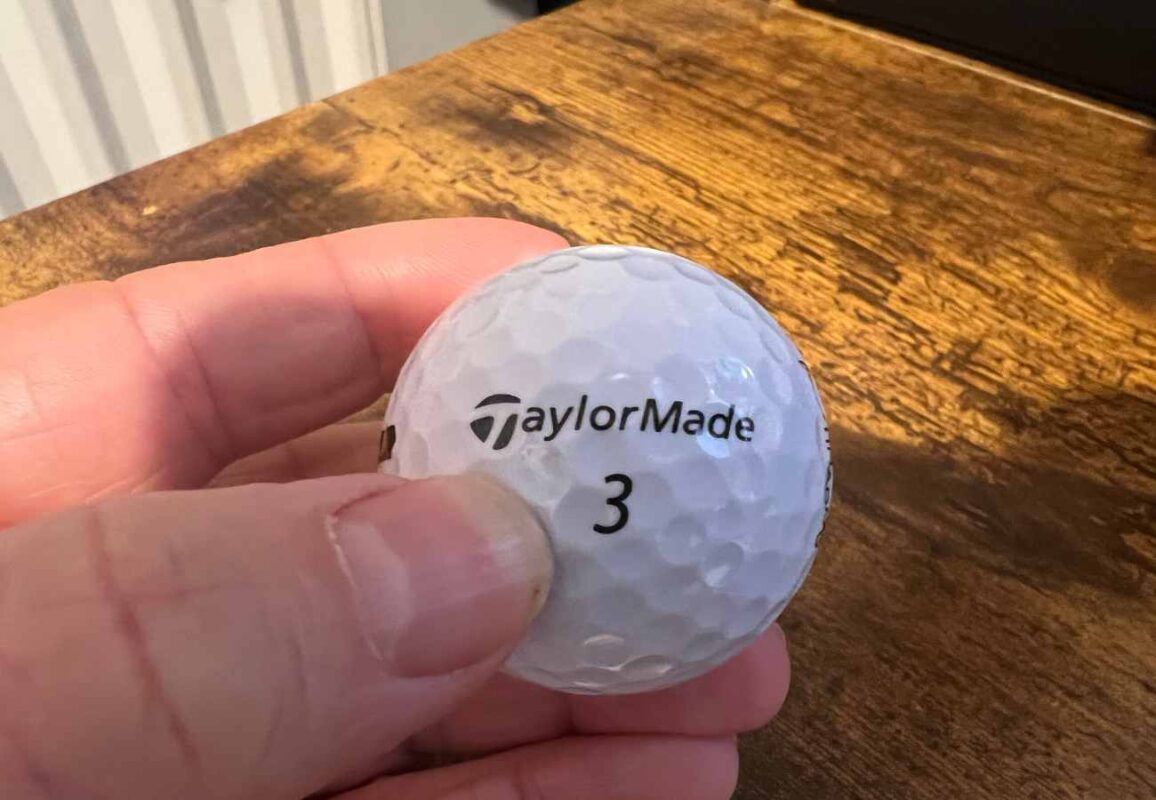
Mid-Handicap golfer who loves to share his rounds and experiences playing courses all around the UK in a hope that it will help others find those hidden gem golf courses.
I seek out golf courses that don’t get the credit they deserve and are often overlooked for the bigger more well known ones.
You may have noticed that golf balls come with numbers printed on them, usually ranging from 1 to 5 or even higher.
Some are even double digits and some famous players always have one particular number printed on their ball.
These numbers are not just for decoration, they actually play a crucial role in the performance of the ball.
In this blog post, we will take a closer look at what these numbers on golf balls mean and how they can affect your game.
Key Takeaway
- The numbers on golf balls typically serve two main purposes: they aid in personal identification during play, and in the case of some brands, indicate the model or type of the ball.
- The different types of numbers on golf balls usually represent either the ball model (with certain brands assigning specific model numbers to various ball types) or a personal identification number, which can be chosen by the golfer for easy recognition during play.
- Red numbers on golf balls typically denote a lower compression suitable for slower swing speeds, while black numbers often indicate a higher compression ball for faster swing speeds.
- Choosing the right golf ball number is more about personal preference for identification during play, as it has no impact on the performance of the ball.

What Do The Numbers On Golf Balls Mean
The numbers on golf balls serve the primary purpose of identifying one’s ball during a game and can also indicate the model or type of the golf ball.
The first numerals were stamped on Titleist and Acushnet golf balls as late as 1945, before which coloured paint was used for identification.
This evolution in the golf ball design was aimed at making it easier for players to distinguish their balls during a game.
In the sport of golf, the numbers imprinted on golf balls serve a very functional purpose – to help players differentiate their own balls from those of others during a game.
This is particularly useful in competitive play where it is crucial not to mistake another player’s ball for your own.
Generally, these numbers are single-digit and are found beneath the brand name on the ball, ranging typically from 1 to 4, though they can be any digit from 0 to 9.
Apart from these single-digit numbers, you may also come across golf balls with two or three-digit numbers. A two-digit number usually signifies the ball’s compression rating.
A lower compression rating, between 70 and 80, translates to a softer feel and is ideal for beginners, seniors, or females who tend to have slower swing speeds.
On the other hand, a higher compression rating indicates a firmer feel, preferred by seasoned golfers with faster swing speeds.

Different Types of Numbers on Golf Balls
Golf balls feature different types of numbers, each serving a specific purpose – these include single-digit numbers for identification, double-digit numbers indicating compression rate, and custom numbers chosen by the player for personal reasons.
Single-Digit Numbers
Single-digit numbers on golf balls, typically ranging from 1 to 4, serve as an identifier during a game. These numbers help players distinguish their own balls from those of others, particularly in competitive play where it’s essential not to mistake another player’s ball for your own.
Double-Digit Numbers
Double-digit numbers usually represent the ball’s compression rating. A lower number, between 70 and 80, suggests a softer feel and is suitable for beginners, seniors, or women who generally have slower swing speeds. Conversely, a higher number implies a firmer feel, preferred by more experienced golfers with faster swing speeds.
Custom Numbers
Custom numbers on golf balls are often selected by players for personal or superstitious reasons. These can be any digit from 0 to 99 and provide an extra layer of personalisation for the golfer. However, they have no bearing on the performance or quality of the ball.
Red vs. Black Numbers on Golf Balls
The red and black numbers on golf balls historically indicated different compression rates, with red representing 90 compression balls and black representing 100 compression balls.
Red Numbers on Golf Balls
Historically, red numbers on golf balls symbolised a compression rating of approximately 90.
This lower compression rating translated into a softer feel when struck, making these balls more forgiving on off-centre hits, and thus generally more suitable for beginners or players with slower swing speeds.
Slower swing speeds, common in seniors or female players, often cannot fully compress a higher-rated ball, leading to sub-optimal distance and feel.
Therefore, a golf ball with a red number, indicating a lower compression rating, was typically the recommended choice for these players.
Black Numbers on Golf Balls
Conversely, black numbers were used to indicate golf balls with a compression rating of 100. These balls offered a firmer feel, which could be beneficial for players with faster swing speeds.
More experienced golfers, who typically have such faster swing speeds, tend to prefer this firmer feel as it offers them greater control over their shots and the ability to shape the ball flight more precisely.
Therefore, a ball with a black number, signifying a higher compression rating, has traditionally been the preferred option for these seasoned players.
Modern Interpretation of Red and Black Numbers
However, in contemporary times, the strict correlation between the colour of the number and the compression rating of the golf ball has become less common.
For example, with the Titleist Pro V1 series of balls, the softer Pro V1 features a black number while the firmer Pro V1x displays a red number, contradicting the traditional interpretation.
This variance underlines that different manufacturers can have different conventions regarding the colour-coding of their golf balls.
How to Choose the Right Golf Ball Number
Choosing the right golf ball number is primarily a matter of individual choice, as it does not directly affect the performance of the ball, but can aid in identification during play.
Personal Identification
A significant reason for selecting a specific golf ball number is to facilitate easy identification on the course. In a group play scenario, being able to quickly identify your ball amongst others can save time and prevent confusion.
By choosing a unique number, perhaps one that isn’t commonly used or stands out to you personally, you can locate your ball more efficiently. This is particularly helpful in competitive situations where every minute counts.
Superstition or Personal Significance
Golfers often attribute their choice of golf ball numbers to personal significance or superstition.
This could range from a lucky number, a date of significance such as a birthday or anniversary, or any number that holds a special meaning to the player.
For some, having this number on their ball may instill a sense of comfort or confidence, enhancing their mental game. This psychological boost, however minor, could potentially lead to improved performance on the course.
Professional Preferences
In the professional golfing world, players tend to stick with a specific number throughout their career for consistency and branding purposes.
This number becomes part of their professional identity, easily recognised by fans, fellow players, and media.
Tiger Woods, for example, is known for consistently using the number 1 on his balls, while Bubba Watson has chosen the more unique number 88. This choice of number becomes part of their brand and can even influence amateur golfers’ choices.
Performance Considerations
While the number itself doesn’t impact the ball’s performance, understanding the ball’s characteristics that suit your playing style is crucial.
Factors such as compression rating, spin rate, and layers can significantly affect your game. Lower compression balls are typically suitable for beginners or players with slower swing speeds, while higher compression balls are preferred by experienced players with faster swing speeds.
Similarly, the spin rate and number of layers in a ball can influence the height and distance of your shots, and the overall feel of the ball.
FAQs
Q: How many digits are typically printed on a golf ball?
A: Golf balls usually have either a one-digit, two-digit, or three-digit number printed on them.
Q: Do the numbers on golf balls have any significance?
A: Yes, the numbers on golf balls can have significance. For instance, some golfers prefer a certain number because it is their lucky number or because it represents a special meaning to them.
Q: What do the three-digit numbers on golf balls mean?
A: The three-digit number on a golf ball typically represents the number of dimples on the ball’s surface. The dimples are the small indentations that help improve aerodynamics and distance.
Find out – How Many Dimples Are In a Golf Ball?
Q: Can the color of the numbers on golf balls vary?
A: Yes, the numbers on golf balls can be printed in different colors, most commonly in red or black.
Q: Do professional golfers have specific preferences for the numbers on their golf balls?
A: Some professional golfers may have preferences for specific numbers on their golf balls, while others may not attach much importance to them. Ultimately, it is a personal preference.
Q: Are there any specific brands that use unique numbering systems on their golf balls?
A: Yes, certain golf ball manufacturers like Titleist, TaylorMade, and Bridgestone often use their own numbering systems as a way to differentiate their products.
Q: Can the numbers on golf balls affect a golfer’s performance?
A: The numbers on golf balls, particularly the compression rating, can have an impact on a golfer’s performance. Golfers with slower swing speeds may benefit from using lower compression balls for increased distance, while those with faster swing speeds may prefer higher compression balls for better control.
Conclusion and final thoughts
In conclusion, understanding the numbers on golf balls is crucial for any golfer looking to improve their game.
By decoding these numbers, players can make more informed decisions on which ball is best suited for their swing and course conditions.
From distance to spin control, each number tells a unique story about the ball’s performance characteristics.
Affiliate Disclaimer – As an affiliate, we may earn a commission from qualifying purchases. We get commissions for purchases made through links on this website from Amazon and other third parties.








Leave a Reply